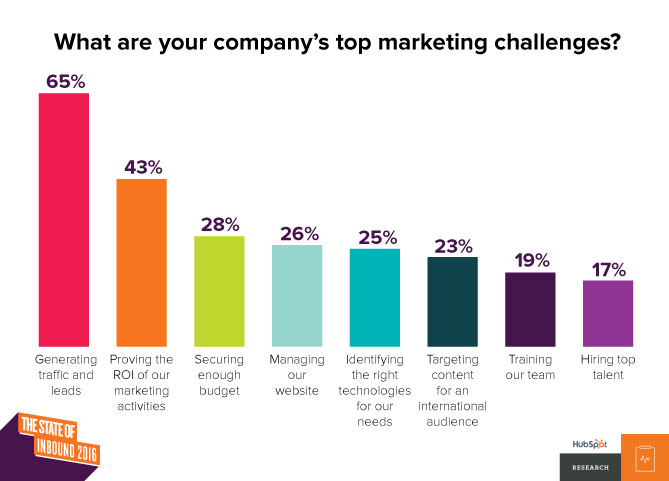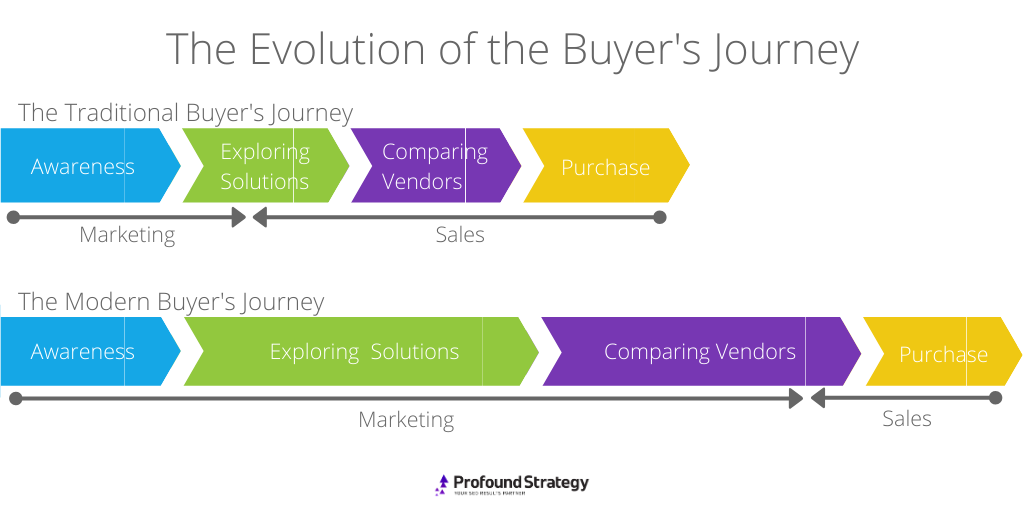B2B Lead Generation & SEO: How to Convert Organic Traffic into Leads
Need more leads? You’re not alone. Marketers’ #1 challenge is generating traffic and leads:

Image source: The 2016 State of Inbound Report
The key to solving that problem is hidden in the challenge: “traffic and leads.”
Many marketers know that SEO is the answer to driving traffic to the website, but fewer consider SEO a lead gen strategy. The truth is, modern SEO can get your business in front of more buyers at more stages of the buyer’s journey than any other single strategy. (Which, if it helps, is also a great way to sell SEO to hesitant executives.)
Whether your team is just starting to put together an SEO strategy, or you’re improving an existing campaign, a few key steps can help pivot your SEO and get your website generation a lot more (qualified) leads.
1. Research the Buyer
You already have buyer personas developed, but an effective SEO strategy requires new details. Fortunately, an effective SEO strategy also comes with a solution for finding those new details.
Applying buyer personas to an SEO strategy means merging the information you have on buyers with the information you have on target keywords, and then perfecting those insights with Google. The result is what we call “user intent;” it is the hidden question behind a keyword.
If a user Googles, “warehousing,” for example, is he looking for information on warehousing strategies, or is he looking for a logistics company that can take care of his warehousing? Is the user’s intent to learn or to purchase?
So dust off those buyer personas and start with what you know: What terms do they use for your products or services? What are some common questions they ask? What are some common misunderstandings?
Then, Google some of those important keywords to make sure you understand what your audience is looking for. You might be surprised.
All of this information gets funneled back to your content marketing strategy, so the content team can create high-quality pieces that your audience is already looking for. Optimizing your existing content is good, but if it’s content no one wants, it’s never going to rank for your target keywords. Content has to answer the user intent to find favor with search engines.
2. Document Your Buyer’s Journey
There are roughly four stages to the buyer’s journey, and stellar content should be created to answer the questions that buyers are asking at each stage.

Once you have your buyer personas updated and user intent defined, you can begin mapping the buyer’s journey, creating entry and exit points for each stage.
- Awareness—Buyers are discovering they have problems. Content that targets this stage of the journey is simple and easy to consume: infographics, videos, SlideShares, and short blog posts that focus on high level topics are good appetizer content. Answer questions like, “What is … ?” to introduce buyers to the concepts surrounding their needs.
- Exploring Solutions—People are actively defining and researching their problems. Make sure your brand is offering thorough, ungated content for each persona in this stage. Long-form content like long blog posts and ebooks are great here, and should answer, “How …?” and, “Why …?” questions.
- Comparing Vendors—People have determined they want or need to make a purchase and are seeking the right solution. Buyers need price charts, third-party comparison reports of you and your competitors, case studies, and in-depth content on how your specific solution works. This is where you start gating content, because if you don’t have an email address by now, you need one.
- Purchase—The buyer chooses a solution. 90% of B2B buyers say that when they’re ready to buy, they’ll contact the brand they have chosen—often without any prior contact with a sales rep.
3. Create Next-Step Conversion Opportunities
When buyer personas are expanded by user intent research, and content is targeted to them along a well-documented buyer’s journey, organic traffic will improve. But organic traffic doesn’t automatically convert to leads, and this is where a lot of B2B brands leave revenue on the table.
The SEO team needs to work hand-in-hand with web dev to make sure each optimized landing page has clear next-step conversion opportunities.
- Early stage visitors who are just becoming aware of their problems, and just beginning to sort out solutions, will likely find your entry-level content, but will soon be ready for more in-depth material. Make sure every blog post links to similar content.
- Mid-stage visitors are interested in the details and are starting to form brand preferences, so offer a mixture of gated and ungated content. 77% of buyers will provide basic information (name and email, etc.) for a whitepaper or similar content, and brands need that info to help nurture leads.
- Late-stage visitors have probably already made a purchase decision, or are very close, which means each one of these visits might be your last chance to grab their attention. Provide testimonials and customer satisfaction statistics, and point them to third-party comparisons and case studies.
Good, modern SEO will get visitors to the right landing pages at the right times, but those pages have to engage buyers and help you collect valuable email addresses.
4. Optimize for Lead Conversions
There is no shortage of great content on the interweb about how to optimize landing pages for conversions. You’ve probably read a lot of them, so I’m not going to regurgitate a long list of tips here.
But I am going to remind you to check Analytics to make sure those pages are actually converting. Too often, marketers do all the right things, or at least we think we do, and don’t bother to actually check. Some useful SEO metrics can help with this:
- Bounce rate— Bounce rate is the percentage of people who leave a site after viewing only one page. Start by checking your highest-traffic pages. If your bounce rate is over 70 percent, those pages needs to be optimized.
- CTR— Click-through rate is the percentage of people who were shown your link and clicked it. If your click-through rate is below the average of 1.91 percent, your title, meta-description, and other page data need to be spruced up.
- Time on site— The amount of time someone spends on a site alludes to their actual engagement with the content. According to research, the optimal blog length is seven minutes, which doesn’t have a direct conversion to words. Visual content (pics, infographics, videos, etc.) can increase view time without padding word counts with fluff.
You’ll also want to make sure to set up goals for each key page in Google Analytics by clicking “Admin” and “Goals.” This allows you to set specific targets for URL visits, page views per visit, view duration, or events, such as clicking a social share button or downloading. These goals give a realistic view of the success of a page and are very useful during A/B testing to quantify changes.
5. Engage Organic Visitors
It’s unrealistic to think every visitor will convert, so focus on remarketing to get the best effect from your SEO efforts. PPC campaigns can be setup to target recent visitors, and anyone who left an email address is expecting to be contacted.
Even your SEO effort itself becomes a remarketing campaign, as you continue finding more niche keywords to rank for related to your business. The more answers an individual gets from you, the more likely they are to trust you enough and contact you as a warm lead.
A presence on popular social networks like LinkedIn and Facebook also helps continue the conversation, providing a place to promote content, generate even more traffic, and further build your SEO conversion strategy.
SEO Should Be a Key Player in Your Lead Generation Strategy
More than just an add-on service for online marketing, SEO is the foundation of any digital marketing strategy. With lower operational costs than call centers, brick and mortar, and other customer contact methods, your website is a cornerstone of your lead generation and customer retention efforts.
Using data-driven SEO techniques, your website will be seen by as many people as possible, and intuitively lead them through your sales funnel. So gather the buyer personas and keyword lists and start getting those ready for an SEO strategy that drives real results.
What's Next?
Profound Strategy is on a mission to help growth-minded marketers turn SEO back into a source of predictable, reliable, scalable business results.
Start winning in organic search and turn SEO into your most efficient marketing channel. Subscribe to updates and join the 6,000+ marketing executives and founders that are changing the way they do SEO:
And dig deeper with some of our best content, such as The CMO’s Guide to Modern SEO, Technical SEO: A Decision Maker’s Guide, and A Modern Framework for SEO Work that Matters.




